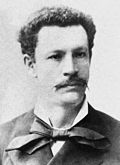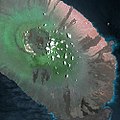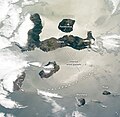Portal:Ecuador
Introduction
 Ecuador, officially the Republic of Ecuador, is a country in northwestern South America, bordered by Colombia on the north, Peru on the east and south, and the Pacific Ocean on the west. It also includes the Galápagos Province which contains the Galapagos Islands in the Pacific, about 1,000 kilometers (621 mi) west of the mainland. The country's capital is Quito and its largest city is Guayaquil. The land that comprises modern-day Ecuador was once home to several groups of indigenous peoples that were gradually incorporated into the Inca Empire during the 15th century. The territory was colonized by the Spanish Empire during the 16th century, achieving independence in 1820 as part of Gran Colombia, from which it emerged as a sovereign state in 1830. The legacy of both empires is reflected in Ecuador's ethnically diverse population, with most of its 17.8 million people being mestizos, followed by large minorities of Europeans, Native American, African, and Asian descendants. Spanish is the official language spoken by a majority of the population, although 13 native languages are also recognized, including Quechua and Shuar. Ecuador is a representative democratic presidential republic and a developing country whose economy is highly dependent on exports of commodities, primarily petroleum and agricultural products. The country is a founding member of the United Nations, Organization of American States, Mercosur, PROSUR, and the Non-Aligned Movement. According to the Center for Economic and Policy Research, between 2006 and 2016, poverty decreased from 36.7% to 22.5% and annual per capita GDP growth was 1.5 percent (as compared to 0.6 percent over the prior two decades). At the same time, the country's Gini index of economic inequality improved from 0.55 to 0.47. One of 17 megadiverse countries in the world, Ecuador hosts many endemic plants and animals, such as those of the Galápagos Islands. In recognition of its unique ecological heritage, the new constitution of 2008 is the first in the world to recognize legally enforceable rights of nature. In the 2024 Global Hunger Index (GHI), Ecuador ranks 58th out of 127 countries with a score of 11.6, which indicates a moderate level of hunger. (Full article...) Selected article -The History of Ecuador covers human habitation in the region reaching back 8,000 years During that period a diversity of cultures have influenced the people and the land that today make up the contemporary Republic of Ecuador. Indigenous tribes inhabited the area for millennia before being invaded and absorbed into the Inca Empire in the early fifteenth century. (Full article...) CategoriesEcuador Articles
General images -The following are images from various Ecuador-related articles on Wikipedia.
Did you know -No recent additions
Related portalsWikiProjectsThings you can do

For more information on how you can help, see the WikiProject Ecuador. StubsLocationsEventsPeople
ProductsOrganizationsArts & EntertainmentEcuador topicsAssociated WikimediaThe following Wikimedia Foundation sister projects provide more on this subject:
SourcesDiscover Wikipedia using portals
| |||||||||||||||||||||||||||||||||||||||||||||||||||||||||||||||||||||||||||||||||||||||||||||||||||||||||||||||||||||||||||||||||||||||||||||||||||||||||||||||||||||||||||||||||||||||||||||||||||||||||||||||||||||||||||||||||||||||||||||||||||||||||||||||||||||||||||||||||||




















































































